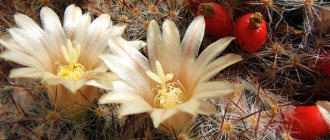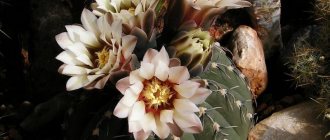Features of cacti of the genus Ripsalidopsis
The history of the genus Rhipsalidopsis is quite complicated. The "Easter cactus" has survived a number of scientific misconceptions. When the first plant species was first discovered and described (in 1884), it was classified as Epiphyllum, later renamed Schlumbergera, then transferred to the genus Rhipsalis, later Epiphilopsis, Rhipsalidopsis and then Hathiora. After numerous changes in taxonomy, cacti have recently been returned to the genus Schlumbergera, although they are still called Rhipsalidopsis, less commonly Hatiora.
The genus Rhipsalidopsis consists of only two species, Rhipsalidopsis gaertneri and Rhipsalidopsis rosea.
These two species belong to epiphytic cacti. They grow in the forests of Southern Brazil, in the states of Minas Gerais, Sao Paulo, Paraná, Santa Catarina and Rio Large del Sul. These places are close to the range of their relatives - cacti of the genus Schlumbergera.
Brief description of Rhipsalidopsis species
Although these two varieties of Easter cactus have almost the same appearance, there are still some differences between them:
- Rhipsalidopsis pink (or "Dwarf Easter Cactus") is a compact, mostly erect, or often arching (or pendulous) cactus with articulated stems.
Photo of blooming Rhipsalidopsis rosea
Flattened stem segments, from 2 to 4 centimeters in length and 1 centimeter in width, during the flowering period (spring) the cactus blooms pink flowers with a diameter of 3 to 4 centimeters. This species was described in 1912 by Lagerheim. - Ripsalidopsis Gartner it is a larger, highly branched epiphytic cactus with a diameter of 30-40 cm with flat stems divided into segments with jagged edges.
Photo of Ripsalidopsis or Schlumberger Gartner
The terminal segments often droop. This species has larger stem segments, from 4 to 7 centimeters in length and from 2 to 2.5 centimeters in width. Bright red flowers, 4 cm long, appear in large numbers in spring, singly or in groups. This species has been described since 1884 by the German botanist von Regel.
What are the differences between cacti of the genus Ripsalidopsis and Schlumbergera or Decembrist
Although two Rhipsalidopsis species have recently been classified as Schlumbergera, there are some visual and flowering differences between them. Due to their external similarity, they are often confused. This often leads to the fact that you may be sold a Schlumberger cactus instead of Ripsalidopsis. Moreover, there are two similar varieties of Zygocactus - Schlumbergera bridgesii and Schlumbergera truncata, which also differ slightly from each other.
How can you tell them apart?
- First of all, this is the flowering period. Rhipsalidopsis blooms in the spring, often during the Easter holidays, which is why it is called the “Spring Cactus” or “Easter Cactus”. Schlumbergera blooms in early winter, before the New Year holidays, accordingly it is called the “Christmas cactus”, “Rozhdestvennik” or “Decembrist”.
- The dormant period is also different - for Decembrist it occurs in February–March, and for Ripsalidopsis from late October to mid-winter.
- Dimensions and appearance of stem segments . Schlumberger's has denticles at the edges of its stems, while Easter Cactus has segments with fine bristles and a smoother, wavy ridge.
If you are planning to acquire this wonderful succulent, pay attention to these features of different species so that you know which plant you are purchasing.
Decembrist: Instructions for Care and Growing Schlumberger at Home
Delicate flower of harsh winter
Very few indoor plants bloom in winter. Therefore, those that can delight us with amazing exotic flowers in the coldest months are especially valued. Such plants include Decembrist or Schlumberger's zigocactus, originally from the South American tropics. Because of the timing of flowering, it is sometimes called Christmas tree.
The information presented in the article will be useful for those who are just planning to acquire a Decembrist flower, and those who are experiencing difficulties with its cultivation, propagation and flowering.
How to grow indoor cactus Ripsalidopsis
Unlike many other succulents that we commonly grow as indoor flowers, Easter Cactus are a member of the epiphytic group of succulents. Their habit of living (in trees and rocks) and their special natural habitat mean that they require very different care than their desert relatives: more water and less light. Learn more about growing these epiphytic cacti at home.
Soil requirements
Ripsalidopsis should be grown in a light, fast-draining soil mixture containing sphagnum moss. This type of soil is usually used for Orchids, Bromeliads or other epiphytic plants. To prepare a soil mixture with your own hands, you need to mix fertile soil based on peat moss with the addition of coarse sand or perlite.
Another option is to mix garden humus, turf soil and fine gravel in a ratio of 2 to 1 to 1. Add a little perlite or fine chips to this soil mixture to increase aeration.
Humidity
Tropical forests in which epiphytic cacti grow have high humidity; this is worth remembering when deciding on the location of the flower pot. During the summer, the air in your room may be too dry. Provide humidity by placing the plant in the kitchen or misting it daily to provide at least a little extra moisture.
Lighting
Rhipsalidopsis loves filtered light, so keep its stems away from direct sunlight. However, additional lighting in early spring stimulates the blooming of flower buds.
Cactus care information
Epiphyllum cactus: how to grow a charming flower correctly
How to water cacti correctly to avoid mistakes in care
How to properly use fertilizer for cacti at home
Temperature
From October to March, the minimum temperature in the place where the flower is kept should be reduced to approximately 10 °C. If you do not follow this regime, the Easter Cactus will not bloom. From March to October, maintain the temperature between 15 and 25 °C. At temperatures above 25 °C the plant is prone to wilting, although it can tolerate heat up to 45 °C.
Remember! Rhipsalidopsis is a tropical plant, which means it does not tolerate low temperatures well.
Hydration
"Easter" requires abundant summer watering, but you need to wait for the soil to dry out slightly between treatments. During the flowering period, keep the plant moist (but not overwatered). Constantly wet soil will quickly lead to root rot.
The only exception is the period after flowering. To give the plant some rest, limit watering for about a month.
Your exact watering schedule will depend on the amount of light your cactus receives, but watering once or twice a week is optimal.
Fertilizer
You can feed the Easter Cactus approximately every two weeks using a balanced liquid fertilizer. Stop feeding during the rest period. Resume fertilizing as soon as the flowers bloom.
Pruning Tips
Pinching dead flowers is done as they dry out. Pruning is not necessary unless you want to control the size of the plant. Once your Rhipsalidopsis reaches the maximum size you want, trim the outer segments of the plant's stems to maintain its shape.
Transfer
Easterflower blooms best when its roots are contained in a somewhat cramped pot, but it should still be repotted every two years into fresh potting mix using a pot one size larger. Replanting should be done in mid-summer after flowering or in autumn.
Types, hybrid varieties and their photos
Buckley
This species of Schlumberger, Buckley can grow up to 40-50 cm , it is distinguished by its dark green coloring of the stems and large, up to 8 cm, pinkish-violet or lilac-pink flowers. The segments are small, with faintly pronounced marginal projections.
Varieties bred on the basis of this species group are distinguished by a variety of colors and shapes of stem segments.
White
Blooming white Schlumbergeras look very elegant and delicate. With good care, almost no stems are visible under the flowers. In cold winter, this type of zygocactus reminds of spring, cherry blossoms and pleases the owner’s eye . Some gardeners compare it to a white swan.
Below in the photo is a flower of the zygocactus species called White Decembrist .
If you plant several varietal Schlumbergers in one flower pot, you will get a fantastic multi-colored composition - a mix .
Home care for mixed Schlumbergers is the same as for other types of zygocactus.
Below is a photo of a Schlumberger mix.
Truncated
Zygocactus truncated grows up to 50 cm , leaf segments up to 6 cm long and up to 3.5 cm wide are painted light green and end with sharp teeth, and two-tiered flowers with petals bent back have a delicate shade from purple and lilac to white-pink .
The most common are bright crimson flowers, but shades can vary, and there are even plants with a smooth transition from pale orange to pale crimson.
Schlumbergera truncated after flowering, a fruit in the form of a pinkish-red berry is formed in place of the flower.
Rousseliana
Zygocactus of this variety does not exceed 30 cm , characterized by glossy stems and flat leaf segments without spines and sharp corners.
The flowers have many elongated, pointed petals of purple, red or pink color and have a greenish peduncle tube.
Hybrids of Rousseliana and truncated are gradually becoming more widespread: due to their increased stability, unpretentiousness and greater elegance, they are gradually replacing Buckley, which has a more traditional appearance and may have become boring to discerning flower growers.
Golden Cream
Blooming Golden Cream delights owners with large flowers from yellow to golden hue. In snowy, monochrome December, it reminds you of the warm summer sun.
It is interesting that breeding yellow flowers became one of the most difficult tasks for gardeners associated with the hybridization of Schlumbergera: this color was absent from the Decembrist’s palette.
Aspen
This variety of zygocactus has double petals ranging from white to faint pale pink and a long tube with yellow stamens at the end.
Pasadena
Multi-tiered flowers of rich red-lilac color enliven the view outside the window and add color to the gray dominant of November-December everyday life. The shape of the flowers and jagged leaves of Pasadena is reminiscent of Boucli.
Madame Butterfly
An interesting variety of the variety has a yellow and white border of stem segments. The flowers are white with a lilac-crimson border that seems to spread to the edges of the petals.
Madonna Dance
The variety stands out among others due to the unusual color of its flowers. The pale shade gradually intensifies towards the edges of the petals, which gives the plant a delicate and at the same time expressive appearance.
Gertner
Schlumbergera Gertnera is a fairly popular house pet among other types of zygocactus; it is distinguished by its bright red-orange flowers, reminiscent of multi-tiered bells, on large shoots.
How to get Rhipsalidopsis to bloom
Flowering of the "Easter cactus" is caused by both a limited amount of light and fairly low temperatures. Your plant needs equal amounts of darkness and light for eight weeks before spring bloom. At night, aim for cooler, drier conditions, ideally around 13-16°C. And although these plants like warmth, do not place your cactus pot near any heat sources. Starting around January, you should close the curtains completely and turn off all the lights in the room the cactus is in after sunset.
Once buds begin to form, plants should not be moved to a new location with radically different light or temperature conditions, as many of the buds will stop developing and their flowering will be interrupted. Flowers will take longer to open if they are not exposed to high temperatures. Plants should bloom for 2-3 weeks at temperatures around 21°C.
Problems that arise when keeping ripsadillopsis at home
Like many flowers, ripsalidopsis is susceptible to some diseases.
The defeat of a bacterial infection is accompanied by rotting of a separate section of the plant. A slippery spot forms at this place. The damaged area must be eliminated. If the trunk is infected, the flower must be transplanted into another pot, removing the infected part.
Damaged plant stems can cause damage to a fungal infection - fusarium. Fungicides are used to treat the plant.
Ripsadillopsis, like other indoor plants, is susceptible to diseases and pests
Infection with phytium and late blight occurs through contaminated soil. The disease affects the roots of ripsalidopsis. The main symptom of infection is the wilting of the plant when there is sufficient moisture. The color of the stems becomes dull and grayish. Antifungal drugs are used for treatment.
Pests are also the cause of diseases in ripsalidopsis.
When infected with spider mites, small colorless dots appear on the stems, increasing over time. A web forms on the back of the stem plates, in which mites reproduce. The plant begins to weaken and wither. To combat the pest, ripsalidopsis must be treated with alcohol or hot water.
The root system and the outer part are affected by the mealybug. A coating begins to appear on the plant, similar to a waxy dense web or cotton wool. In this case, it is necessary to transplant the ripsalidopsis into new soil, washing the roots with a solution of potassium permanganate, and alcohol, calendula tincture or special chemicals are suitable for treating the stems.
The infestation of a plant by scale insects is difficult to determine in the early stages. But if you look closely you can see the parasites. They look like fast moving specks. Over time, brown lumps and sticky liquid appear on the stems, in which sooty fungus can appear and make the situation even worse. To destroy the parasite, the plant is treated with alcohol or an insecticide.
To prevent diseases and the appearance of pests, the stems of ripsalidopsis must be periodically wiped, dried stems must be removed, and the creation of a favorable environment for the appearance of parasites must be prevented.
Ripsalidopsis, like all plants belonging to the cactus family, is an excellent absorber of negative influences. If the plant is not sick and feels good, it forms an energy cycle. Energy fluctuations in ripsalidopsis are wavy. It is concentrated at the base of the plant and comes out of it like fountains, rising and falling.
Ripsalidopsis will decorate any room, its long stems will look great in a hanging flower pot, and its bright flowers will create a mood and fill the room with a delicate aroma. When purchasing a plant, you can be sure that its powerful energy will protect you from negativity, negative emotions and will have a positive effect on the home atmosphere.
Diseases and pests of indoor “Easter cactus”
Like any other member of the Cactus family, Ripsalidopsis can suffer from root rot if it is constantly overwatered. Although these plants are moisture-loving, try not to overdo it with watering, find a middle ground between wet and dry soil.
These flowers are also susceptible to attacks by spider mites and mealybugs. Regularly inspect the Easter egg for the presence of these insects and try to remove them as quickly as possible. How to deal with pests is described in our article.
Why are these two plants confused?
Schlumbergera and ripsalidopsis are confused quite often, although they belong to different genera of succulents . Both of these plants come from the tropical forests of Latin America and outwardly they are practically indistinguishable from each other. Leaves with small segments, up to 2 cm long, form a spreading small bush. Flowers of red and pink shades bloom at the ends of the branches.
Both of these succulents are called epiphytic cacti because in nature they live on tree branches, using them as support.
Reproduction of Ripsalidopsis
This flower can be easily propagated by cutting off segments in the summer after your plant has finished flowering. How to properly reproduce?
- Cut or carefully break off one or more apical segments of healthy branches.
- Place the cuttings in a cool, dry place for a few days to allow the cut ends to heal. Insert the base of the cutting 3cm into a mixture of damp sand, perlite or vermiculite.
- Once the new roots are firmly established (about 2-3 weeks), move the young cactus to a suitable pot with a rich, fast-draining potting mix.
The plant can also be propagated by seeds, as well as by grafting. Seeds usually germinate easily, although seedlings take longer to develop into flowering cacti than cuttings.
How is it different from Schlumbergera?
Sometimes ripsalidopsis is confused with Schlumbergera, popularly known as Decembrist. The main differences appear in the flowering conditions of the cactus - Decembrist blooms in winter, and Easter blooms from spring to summer. Some differences are also noticeable in the appearance of the plants. Ripsalidopsis has smoothed protrusions at the edges, and Schlumbergera has sharp teeth.
Moreover, in the former, the flowers grow with an even, radially symmetrical corolla, while in the latter, they have beveled corollas.
Varietal varieties of the genus Ripsalidopsis
As previously stated, the genus Rhipsalidopsis consists of two species. All Easter Cactus varieties are hybrids, often called Rhipsalidopsis x graeseri. In 1985, the English review “Epiphytes” mentioned 44 varieties of Rhipsalidopsis hybrids. Already in 1995, the list of hybrid varieties exceeded 200 varieties.
Hybrids are created around the world by many famous breeders in Australia, the USA, Japan, Denmark, Germany and the Netherlands and other countries. Basically, the varieties differ from each other in the color palette of indoor cactus buds. We will briefly describe the most popular of them.
Varieties of Ripsalidopsis Gartner (Rhipsalidopsis gaertneri)
At the moment, you can find many varieties on the market with different petal colors:
- 'Scorpion' . Bright red flowers up to 5 cm in diameter appear in abundance from March to May. Each bud blooms for several weeks, opening every morning after sunrise and closing at sunset.
- Variety 'Nina' . This variety has lilac-colored flowers.
- 'Elisa' . The cactus produces burgundy buds, but the flowers themselves are carmine in color.
- 'Sirius' . This cactus has white flowers.
- Variety 'White magic' . Another variety with white flowers. The flowering period is short. To prolong it, you need to pinch off faded flowers.
Comparison table
| Escapes | Flowers | Rest period | Flowering period | Period of active growth | |
| Schlumberger | segments with sharp teeth on the edges | tube-shaped, elongated, beveled | September-November, February-March | November-January | March-September |
| Rhipsalidopsis | segments with rounded edges | daisy-shaped, star-shaped | September-January | March-May | June August |
Transfer
If the Decembrist does not bloom, you can try replanting it in a container 2 cm larger than the previous pot. This will make it possible to expand the area of the roots and provide nutrition to the leaves so that flower stalks can be formed.
The rules for transplanting the Decembrist zygocactus are as follows:
- A drainage layer is placed at the bottom, which makes up a third of the total volume of the pot.
- A layer of prepared soil is poured onto it.
- The plant is removed from the old pot and rearranged into a new one.
Before transplanting, inspect the roots to remove rotten or dry ones. The sections are treated with activated carbon.










